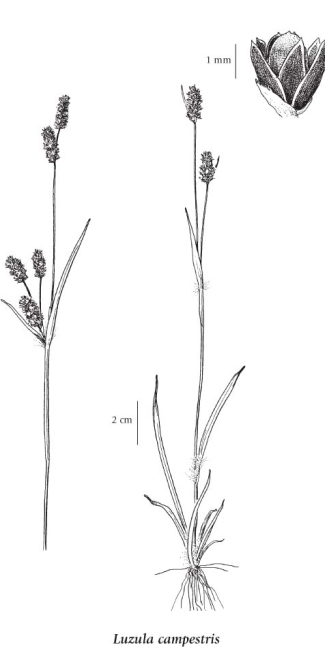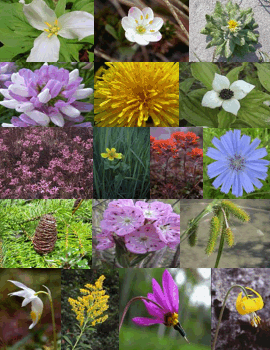Luzula campestris (L.) DC.
field wood-rush (field woodrush)
Juncaceae (Rush family)
Introduction to Vascular Plants
field wood-rush (field woodrush)
Juncaceae (Rush family)
Introduction to Vascular Plants
SUBTAXA PRESENT IN BC click to expand contents
Luzula campestris ssp. campestris
Species Information click to expand contents
General:
Perennial herb from long, creeping rhizomes and stolons; stems 5-25 cm tall.
Leaves:
Flat, fringed with fine hairs, 2-5 cm long, 2-3.5 mm wide, gradually tapering to the tips; sheaths green.
Flowers:
Inflorescence dense, with 2 to 7 clusters on stiff stalks, each cluster with 3 to 10 flowers, without remote basal flowers; perianth segments green to dark brown or chestnut-brown, 2.5-4.5 mm long, egg-shaped, pointed or short-awned, the inner about the same length as the outer; stamens 6; anthers 1.2-1.8 mm long, much longer than the filaments; bractlets scarcely fringed with fine to coarse hairs, shorter than the flowers and 1/2 the length of the perianth segments; lower bract leaflike, well developed, shorter than the inflorescence.
Fruits:
Capsules, egg-shaped, blunt, about the same length as the perianth segments; seeds rounded, slightly elongated, 0.9-1.2 mm long, with basal appendages.
Notes:
The name "L. campestris" has been applied to a number of members of Luzula section Luzula. When applied in a strict sense, it corresponds to the taxon that has long rhizomes and stolons.
Illustration click to expand contents

If more than one illustration is available for a species (e.g., separate illustrations were provided for two subspecies) then links to the separate images will be provided below. Note that individual subspecies or varietal illustrations are not always available.
Illustration Source: The Illustrated Flora of British Columbia
Ecology click to expand contents
Ecological Framework for Luzula campestris
The table below shows the species-specific information calculated from
original data (BEC database) provided by the BC Ministry of Forests and Range.
(Updated August, 2013)
The table below shows the species-specific information calculated from
original data (BEC database) provided by the BC Ministry of Forests and Range.
(Updated August, 2013)
| Site Information |
Value / Class |
||
|
Avg |
Min |
Max |
|
| Elevation
(metres) |
1102 | 455 | 1750 |
| Slope
Gradient (%) |
15 | 0 | 40 |
|
Aspect (degrees) |
261 | 20 | 290 |
| Soil
Moisture Regime (SMR) [0 - very xeric; 4 - mesic; 8 - hydric] |
2 | 1 | 5 |
| Modal
Nutrient Regime
Class |
C | ||
| #
of field plots species was recorded in: |
7 | ||
| Modal
BEC Zone Class |
BAFA | ||
|
All BEC Zones (# of stations/zone) species was recorded in |
BAFA(1), ICH(1) | ||
|
Source:
Klinkenberg 2013
|
|||
Habitat and Range click to expand contents
Moist lawns in the lowland zone; rare in SW BC, known only from Courtenay and possibly the lower Fraser valley; introduced from Europe.
Status Information click to expand contents
Synonyms click to expand contents
Synonyms and Alternate Names:
Juncoides campestre (L.) Kuntze
Luzula campestris var. congesta (Thuill.) E. Mey.
Luzula campestris var. minor (Satake) S.L. Welsh
Luzula comosa var. congesta (Thuill.) S. Watson
Luzula kobayasii Satake
Luzula kobayasii var. minor Satake
Luzula multiflora subsp. congesta (Thuill.) Hyl.
Luzula multiflora var. congesta (Thuill.) W.D.J. Koch
Luzula multiflora var. minor (Satake) Roy L. Taylor & MacBryde
